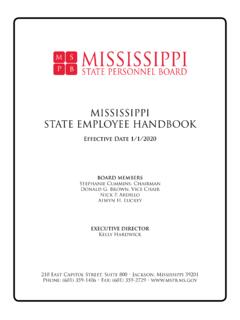Transcription of State of New Jersey
1 ATTORNEY GENERAL GUIDELINES TO: All Law Enforcement Chief Executives and County Prosecutors FROM: Andrew J. Bruck, Acting Attorney General DATE: December 7, 2021 SUBJECT: Promoting Diversity in Law Enforcement Recruiting and Hiring In order to most effectively serve the communities of New Jersey , it is important for law enforcement agencies to strive for workforces that reflect the diversity of the jurisdictions they serve and that can effectively interact with all community members. With this need in mind, in October 2020 the Legislature passed a law requiring each law enforcement agency in New Jersey to establish a program designed to ensure every agency was comprised of law enforcement officers who reflect the diversity of the population of the community the agency is charged with protecting. 52 et seq. (the Act ). The Act directed the Attorney General to develop these Guidelines to ensure its uniform application. These Guidelines describe the process by which each agency shall establish a program to (1) identify underrepresented groups and (2) take action to address any , in accordance with the Act, these Guidelines set forth procedures for the collectionand reporting of demographic data regarding recruiting, hiring, promoting, and other personnelactions concerning law enforcement officers in New is important to note that most large law enforcement agencies in New Jersey are governed by civil service statutes and regulations.
2 See 11A:1-1 et seq.; 4A: et seq. This system requires the agency to hire police officer candidates from certified lists supplied by the New Jersey Civil Service Commission ( CSC ) following a State -administered testing process. The CSC typically administers this testing process every two to three years, and the CSC uses the results to compile a ranked list of qualified law enforcement candidates. For agencies that utilize this process, they are limited to the list of qualified candidates provided by CSC only candidates who fail background checks, medical/psychological exams, residency requirements (or similar, non-discretionary factors), may be removed from or bypassed on the lists. 1 Nothing in these Guidelines shall impair a law enforcement agency s otherwise legally permitted recruiting and hiring practices. PHILIP D. MURPHY GovernorSHEILA Y. OLIVER Lt. GovernorState of New Jersey OFFICE OF THE ATTORNEY GENERAL DEPARTMENT OF LAW AND PUBLIC SAFETYDIVISION OF CRIMINAL JUSTICEPO BOX 085 TRENTON, NJ 08625-0085 TELEPHONE: (609) 984-6500 ANDREW J.
3 BRUCK Acting Attorney GeneralLYNDSAY RUOTOLO Director2 More specifically, pursuant to the CSC s rule of three, the CSC provides an agency seeking to hire a new officer with the top three candidates from the CSC s certified list. The hiring agency is then limited to those three candidates to fill the vacancy. Veterans of military service who pass the exam are given preference and placed at the top of the certified list. As a result, agencies governed by civil service will face additional processes in their efforts to address underrepresentation. These Guidelines provide suggestions for actions to be taken in that regard, including making CSC test preparation courses widely available. In addition, agencies should be aware of and become familiar with 2021 legislation, , , 235, 236, which aim to address various barriers to diversity that arise in CSC jurisdictions and contain certain CSC data collection requirements. Definitions Applicant.
4 O Non-civil service jurisdictions: An applicant in a non-CSC jurisdiction is an individual seeking employment as a law enforcement officer and who has submitted a completed employment application as provided by the hiring law enforcement agency, regardless of whether or not the individual has undergone an examination, a background check, or any other prerequisites to employment used by the hiring agency. o Civil service jurisdictions: An applicant in a CSC jurisdiction is an individual seeking employment as a law enforcement officer and who (1) is included on a CSC certified list of eligible candidates received by a hiring law enforcement agency and (2) responded timely to the hiring agency with an expression of interest in the position. Applicant also includes individuals who are exempted from the CSC examination requirement under 11 and who submit a completed employment application as provided by the hiring agency.
5 Appointment. A law enforcement officer is appointed by the resolution of the agency s governing body. Law enforcement agency. Defined in the Act as a department, division, bureau, commission, board or other authority of the State or of any political subdivision thereof which has by statute or ordinance the responsibility of detecting and enforcing the general criminal laws of this Law enforcement officer. Defined in the Act as any person who is employed as a permanent full-time member of an enforcement agency, who is statutorily empowered to act for the detection, investigation, arrest, and conviction of persons violating the criminal laws of this State and statutorily required to successfully complete a training course 2 Because the Department of Corrections (DOC) is not assigned the responsibility of detecting and enforcing the general criminal laws of this State , DOC does not fall within the Act s statutory definition of law enforcement agency.
6 3 approved, or certified as being substantially equivalent to an approved course, by the Police Training Commission pursuant to , ( :17B-66 et seq.). I. Establishing a Program A. Purpose. As expressly required by the Act, each law enforcement agency in the State shall establish a program (the Program ) in furtherance of the goal of the agency being comprised of law enforcement officers who reflect the diversity of the population of the community the agency is charged with protecting. Each agency shall make a good faith effort to meet specific goals for recruiting a diverse workforce, in terms of people of color and gender B. Setting goals. Each agency will be responsible for establishing its own specific Program goals. In forming its Program goals, the agency should at least annually analyze the demographics of its law enforcement officers and determine if there is a substantial disparity between the racial, ethnic, and gender representation within the law enforcement officer ranks as compared with the racial, ethnic, and gender representation in the relevant population of the jurisdiction served by the Any demographic group for which there is a substantial disparity, in terms of less representation on the police force, should be considered an underrepresented group.
7 In determining whether a disparity is substantial, agencies should consider whether reducing the disparity would help achieve the Act s goal of each agency s police force reflect[ing] the diversity of the population of the community the agency is charged with protecting and thereby making the police force more effective at promoting public safety. The Program goals should describe (1) the identified underrepresentation of any group, (2) the means for addressing the underrepresentation, and (3) the intended time frame for doing so. C. Addressing underrepresentation. Identified underrepresentation may be addressed by some or all of the below-listed actions, as well as others, which should be detailed in the Program goals. The means of addressing underrepresentation shall not include quotas or any other legally impermissible provisions. 1. Using recruitment methods that target underrepresented demographic groups, especially local recruitment efforts.
8 This approach may include outreach to law 3 We recognize, however, that achieving a truly diverse workforce involves numerous other considerations in addition to the race, ethnicity, and gender categories specified in the Act. For example, LGBTQ+ Law Enforcement Liaisons operating throughout the State perform valuable engagement with members of that community. Finally, the Act referred to minorities, but these Guidelines will refer to people of color when referring to racial and ethnic diversity. 4 Demographic data for local populations searchable by municipality and county is available at the Census website: Additionally, the following URL links to a pre-filtered table on the Census website that shows data for the adult population of all New Jersey municipalities and counties: ,34%240500000,34%24160000&tid= 4 enforcement officer organizations based on race, ethnic group, gender, or religion;5 local colleges with significant student diversity; minority-serving educational institutions;6 and military veterans.
9 Such methods may also include ensuring recruitment materials that (1) reflect visible diversity, (2) are reviewed by a diverse team prior to release, and (3) are delivered by a diverse recruiting team. The diversity of those conducting applicant interviews should also be considered. Finally, recruiting methods may involve establishing pipeline programs that foster and enhance an interest in law enforcement among diverse youth populations as early as middle school. 2. Implementing standardized forms in the application process that reduce subjective responses that may impact the hiring of underrepresented groups, and training the recruiting and hiring team on explicit and implicit bias. 3. Instituting clear criteria for hiring and an oversight process for reviewing hiring decisions. With respect to hiring, consider making publicly available information on examples of background-check issues that can disqualify applicants.
10 4. Assessing whether particular hiring eligibility requirements adversely affect any underrepresented group and, if so, reassessing whether the requirement is essential. If the requirement is deemed essential, consider developing appropriate supportive initiatives or alternative paths, such as remedial training or deferral options. For example, if background checks consistently disqualify an underrepresented group due to prior financial issues such as bad credit history or bankruptcy, consider whether a mechanism for waiving the requirement in appropriate cases is warranted. 5. Assessing what the barriers are to applications by underrepresented groups and devising solutions to overcome those barriers. For example, underrepresented groups may not submit applications because the process is online and potential applicants do not have ready access to resources to complete the application. In such a case, the Program might seek to address the problem by using mobile units equipped with computers to allow onsite applications.

















